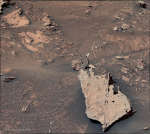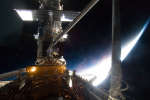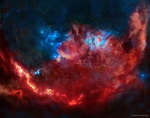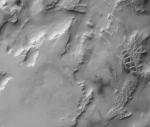
|
You entered: origin
 The Magellanic Stream
The Magellanic Stream
25.01.2010
Spanning the sky toward the majestic Clouds of Magellan is an unusual stream of gas: the Magellanic Stream. The origin of this gas remains unknown but likely hold a clue to origin and fate of our Milky Way's most famous satellite galaxies: the LMC and the SMC.
 Gamma rays and Comet Dust
Gamma rays and Comet Dust
20.08.2016
Gamma-rays and dust from periodic Comet Swift-Tuttle plowed through planet Earth's atmosphere on the night of August 11/12. Impacting at about 60 kilometers per second the grains of comet dust produced this year's remarkably active Perseid meteor shower.
 A Patch of Spherules on Mars
A Patch of Spherules on Mars
16.02.2004
Some patches of Mars are full of mysterious tiny spherules. The microscopic imager on board the Opportunity rover on Mars recorded, last week, the above image showing over a dozen. The image was taken near a rock outcrop called Stone Mountain and spans roughly 6 centimeters across.
 Rock Fingers on Mars
Rock Fingers on Mars
20.06.2022
There, just right of center, what is that? The surface of Mars keeps revealing new surprises with the recent discovery of finger-like rock spires. The small nearly-vertical rock outcrops were imaged last month by the robotic Curiosity rover on Mars.
 The Mysterious Methane of Mars
The Mysterious Methane of Mars
21.12.2014
What's creating methane on Mars? Recent measurements from the robotic Curiosity rover currently rolling across Mars indicate a surprising 10-fold increase in atmospheric methane between measurements only months apart. Life is a major...
 Above Earth Fixing Hubble
Above Earth Fixing Hubble
20.05.2009
What is that astronaut doing? Fixing the Hubble Space Telescope. During the fourth servicing mission to upgrade and fix Hubble, astronaut Michael Good can be seen attached to the shuttle's robotic arm, working in an open panel of Hubble. Far below, the terminator between day and night can be seen across planet Earth.
 Orion in Red and Blue
Orion in Red and Blue
13.04.2016
When did Orion become so flashy? This colorful rendition of part of the constellation of Orion comes from red light emitted by hydrogen and sulfur (SII), and blue-green light emitted by oxygen (OIII). Hues...
 Orion in Red and Blue
Orion in Red and Blue
14.10.2018
When did Orion become so flashy? This colorful rendition of part of the constellation of Orion comes from red light emitted by hydrogen and sulfur (SII), and blue-green light emitted by oxygen (OIII). Hues...
 High Velocity Clouds and the Milky Way
High Velocity Clouds and the Milky Way
14.12.1999
Where are these gas clouds going so quickly? High velocity clouds (HVCs) of gas have been seen for decades but their origins and destinations have remained mysterious. Recent measurements have now placed at least...
 Rectangular Ridges on Mars
Rectangular Ridges on Mars
1.10.2002
What could cause rectangular ridges on Mars? As data flows in from the two spacecraft currently orbiting Mars, surface structures are seen that are not immediately understood. These structures pose puzzles that planetary geologists are eager to solve, as they might provide clues to past processes that have shaped Mars over billions of years.
|
January February March April |
|||||||||||||||||||||||||||||||||||||||||||||||||